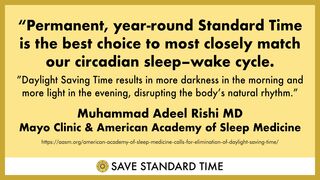Sleep
Standard Time Returns: 4 Ways to Reset Your Circadian Clock
Light exposure is the primary force that daily resets the circadian clock.
Posted November 3, 2021 Reviewed by Tyler Woods
Key points
- Go to be early rather than using the "extra" hour to stay up late.
- Expose yourself to early morning light. Look up at the sky. Ditch the glasses.
- Unwind starting at dusk. No afternoon coffee. Eat dinner earlier than you are accustomed to.
- With fewer hours of daylight, evening screen light disrupts natural melatonin. Engage night shift and dark modes.
I have written several times here about circadian rhythms and the downsides of changing the clock ahead and back twice a year—including deadly reasons why Daylight Savings is bad for you, why many hate the switch back from Daylight to Standard time, and how to fix Daylight Savings disruptions.

Why? Because the circadian clock in the human brain is one of the most important pieces of biology we have. It is also one of the most misunderstood forces that affects us, which is a pity because it literally governs everything.
All life forms—from bacteria that appeared 3.8 billion years ago to humans a mere 300,000 years ago—beat in time with the circadian clock that imposes a 24-hour rhythm in step with the planet’s rotation. All physiology is rhythmic. A central timekeeper in the suprachiasmatic nucleus (SCN) of the hypothalamus acts like an orchestra conductor that keeps all the players in synch.
Go To Bed Early
With the change back to Standard Time I advise you to resist the temptation to say up late. Instead, use the "extra hour" gained by turning the clock back to go to bed early. The clock may say one thing, but your body is still on Daylight Savings Time when you turn in, and it stays that way for a while. The body needs time to adjust. The time change isn’t like flipping an electrical switch. Some people need a week or more to get back in sync with astronomical time dictated by Earth’s rotation.
What a large difference a single hour makes! Our annoyance with it is one reason many people protest having to switch back and forth twice a year and wish politicians would pick one standard and stick to it. Medical experts argue that permanent Standard Time has many advantages.

Expose Yourself to Morning Sunlight.
Turning in early inevitably makes you wake up early. You can use the new morning hours to take a walk or engage in outdoor exercise. Give priority to daylight because the sun naturally regulates the body’s circadian clock. Morning exposure to natural sunlight will help you wake up refreshed and makes falling asleep easier at night. If you can’t leave the house, at least throw open the curtains each morning. Look up at the sky, and ditch sunglasses and even regular glasses.
The modern notion of what constitutes a normal sleep pattern differs from that during most of human history when daily life largely took place out of doors. Living in huts, castles, condos, suburban split–levels, office buildings, and skyscrapers are all extremely recent developments. For most of human existence, we lived in harmony with the natural rhythms of light and dark.
Gas and electric lighting became popular only 120 years ago, while brain and body both still took their timing cues from the sun’s rising and setting. We can’t do otherwise given that intrinsic biological clocks regulate alertness, mood, behavior, and even patterns of thoughts. Most of these clocks reside in the brain, while the heart and digestive systems have robust timekeepers of their own.
Unwind Starting at Dusk
The SCN, along with tracts from the retina to the hypothalamus, are particularly sensitive to short-wave light that outwardly looks a bluish-green, called “cyan.” Because of the way sunlight scatters upon entering Earth’s atmosphere, cyan light predominates just before sunrise and again after sunset. The SCN registers the time of these peaks whereas overall light exposure is the primary force that daily resets the circadian clock. No drug can shift the circadian phase to a new time zone the way that going to bed does.
Just three generations ago people got an average of ten hours of daylight every day. Today, interior office light measures about 300 lux and the average home even less, whereas outdoor light intensity can measure 50,000 lux. If we don’t allow ourselves vigorous daytime exposure to sunlight the SCN becomes overly sensitive to the short wavelengths that predominate at twilight, mistakenly telling us to “wake up” when exposed to the bright, short-wave light thrown off by the devices we currently use in the evening.
Evening hours before iPhones and Tablets
Before the advent of iPhones and tablets held close to the face, the largest source of short-wave light was the sun. The only way to meaningfully reduce the light energy hitting us from this spectral range, aside from shutting devices off after sunset, is to turn down the brightness of the blue channel (the tall peak the left of the figure) and engage the blue/yellow (tritanopia) filter.
Up next: how to dial back short-wave light after dusk that comes from TVs and screens of every sort.


